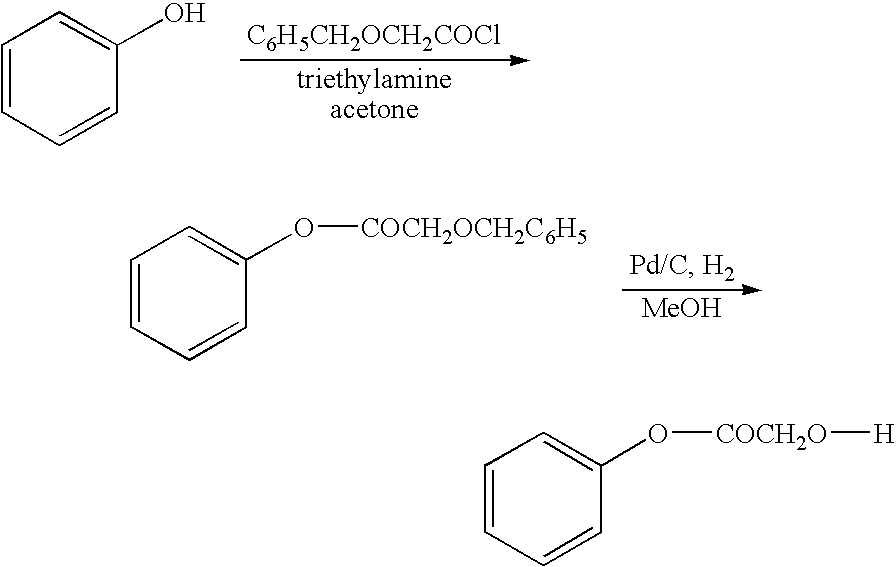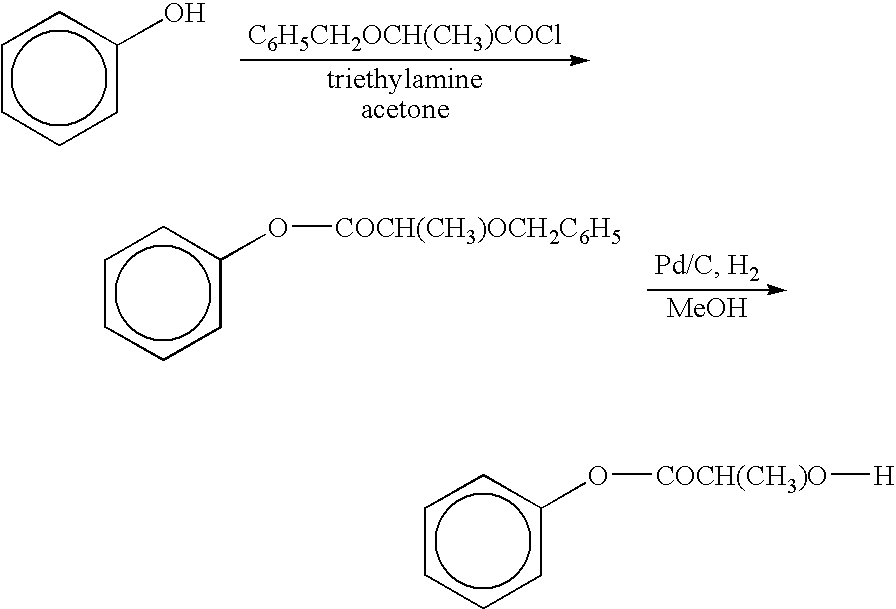Functionalized phenolic esters and amides and polymers therefrom
a technology of which is applied in the field of functionalized phenolic esters and amides and polymers therefrom, can solve the problems of difficult hydrolysis and difficult polymerization in the phenolic state, and achieve the effect of altering the native value or efficacy
- Summary
- Abstract
- Description
- Claims
- Application Information
AI Technical Summary
Benefits of technology
Problems solved by technology
Method used
Image
Examples
example-1
Benzyloxy-acetic acid 4-(2-benzyloxy-acetoxy)-phenyl ester
[0101]
[0102] To a mixture of Hydroquinone (10 grams, 90.9 mmol), Triethylamine (51 ml, 366 mmol) in acetone (300 ml) at 10° C. was added Benzyloxy acetyl chloride (50 grams, 271 mmol) drop wise, later stirred at room temperature for 18 hours. Solids were filtered off, acetone distilled and water (100 ml) was added. Crude 1 was extracted into chloroform, washed with 5% sodium bicarbonate solution (2×50 ml), water (2×50 ml), dried over sodium sulphate and distilled. The crude 1 was recrystallised from chloroform: hexane (1:5) to get pure 1 (17 grams, 46%) as a light brown powder. The melting point was measured for all the products by using Polmon (MP 96) melting point apparatus, and the melting point found to be 122-124° C. For all the products, NMR was run using Varian 200 MHz and tetramethylsilane as an internal standard. The structure was confirmed by using NMR.
[0103]IHNMR(CDCl3) δ 4.35(s,2H,CH2), 4.71(s,2H,CH2), 7.14(s,2H...
example-2
Hydroxy-acetic acid 4-(2-hydroxy-acetoxy)-phenyl ester
[0104]
[0105] Benzyloxy-acetic acid 4-(2-benzyloxy-acetoxy)-phenyl ester 1 (20 grams, 49.2 mmol) was dissolved in Dimethyl formamide (200 ml) in a pressure vessel, Palladium on carbon (5%, 20 grams) added and the mixture stirred under an atmosphere of hydrogen (4 Kg) for 22 hours. The catalyst was removed by filtration and distilled off the Dimethyl formamide under vacuum. The crude 2 was purified by column chromatography on silica gel using chloroform: Ethyl acetate (95:5) and further purified by recrystallising in chloroform: methanol (5:1) to get pure 2 (3 grams, 27%) as a white powder. The melting point was found to be 162-163° C., and the structure was confirmed by using NMR.
[0106]IH NMR (DMSO,d6) δ 4.28(d,2H,CH2), 5.58(t,1H,OH), 7.20(s,2H,Ar)
example-3
Benzyloxy-acetic acid 4-acetylamino-phenyl ester
[0107]
[0108] To mixture of Paracetamal (25 grams, 165 mmol) Triethylamine (41.5 grams, 410 mmol) in acetone (250 ml) at 10° C. was added benzyloxy acetyl chloride (40 grams, 217 mmol) drop wise, later stirred at room temperature for 16 hours. The solids were filtered off, acetone distilled and water (200 ml) was added. Crude 3 was extracted into chloroform, washed with 5% sodium bicarbonate solution (2×100 ml), water (2×100 ml), distilled and purified by column chromatography on silica gel using benzene as eluant to get pure 3 (30 grams, 60.7%) as a light brown powder. The melting point was found to be 106-108.8° C., and the structure was confirmed by using NMR.
[0109]IH NMR (CDCl3) δ 2.10(s,3H,COCH3), 4.30(s,2H,CH2), 4.68(s,2H,CH2), 6.96(d,2H,Ar), 7.31(m,5H,Ar), 7.45(d,2H,Ar), 7.68(bs,1H,NH)
PUM
| Property | Measurement | Unit |
|---|---|---|
| temperature | aaaaa | aaaaa |
| melting point | aaaaa | aaaaa |
| melting point | aaaaa | aaaaa |
Abstract
Description
Claims
Application Information
 Login to View More
Login to View More - R&D
- Intellectual Property
- Life Sciences
- Materials
- Tech Scout
- Unparalleled Data Quality
- Higher Quality Content
- 60% Fewer Hallucinations
Browse by: Latest US Patents, China's latest patents, Technical Efficacy Thesaurus, Application Domain, Technology Topic, Popular Technical Reports.
© 2025 PatSnap. All rights reserved.Legal|Privacy policy|Modern Slavery Act Transparency Statement|Sitemap|About US| Contact US: help@patsnap.com



